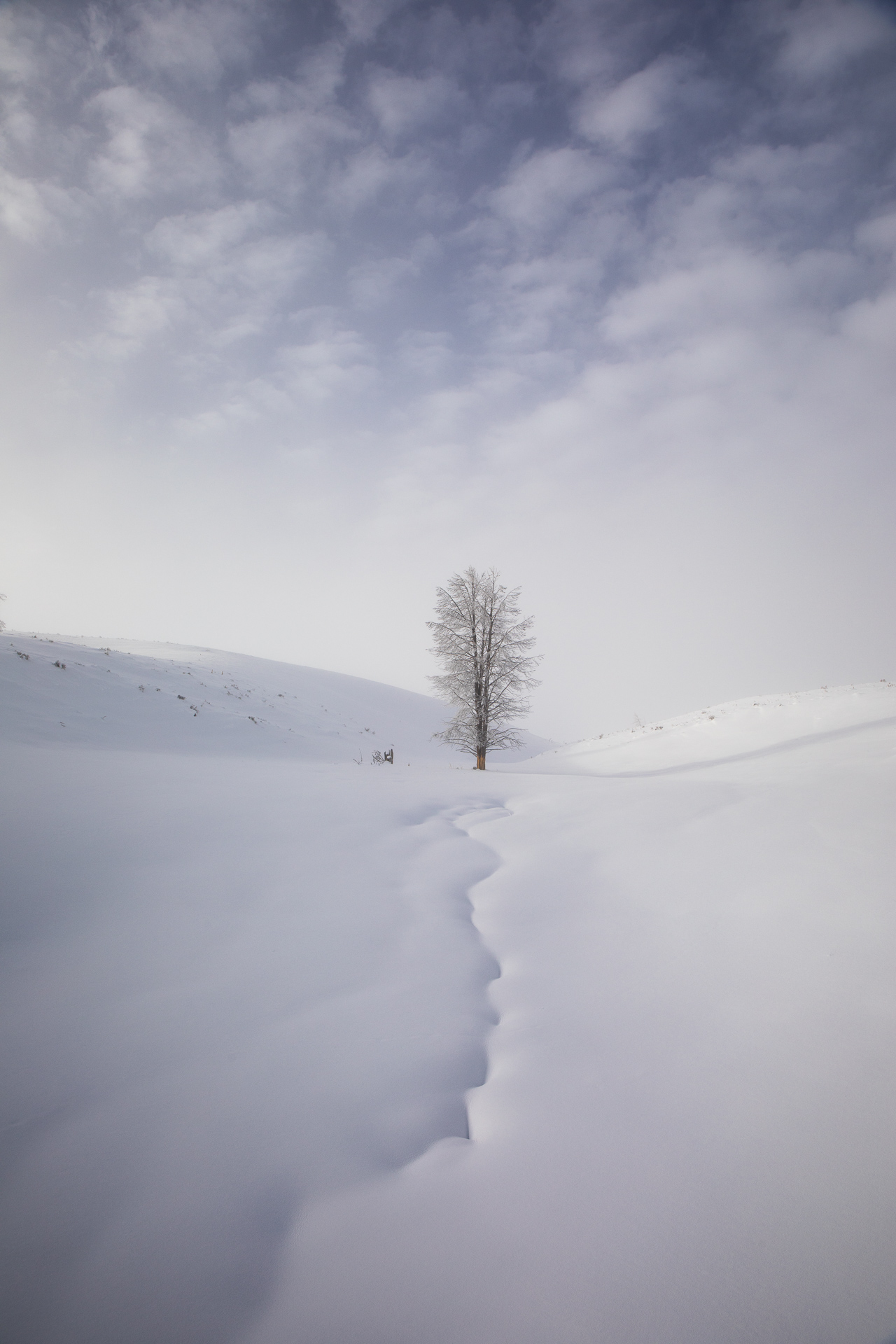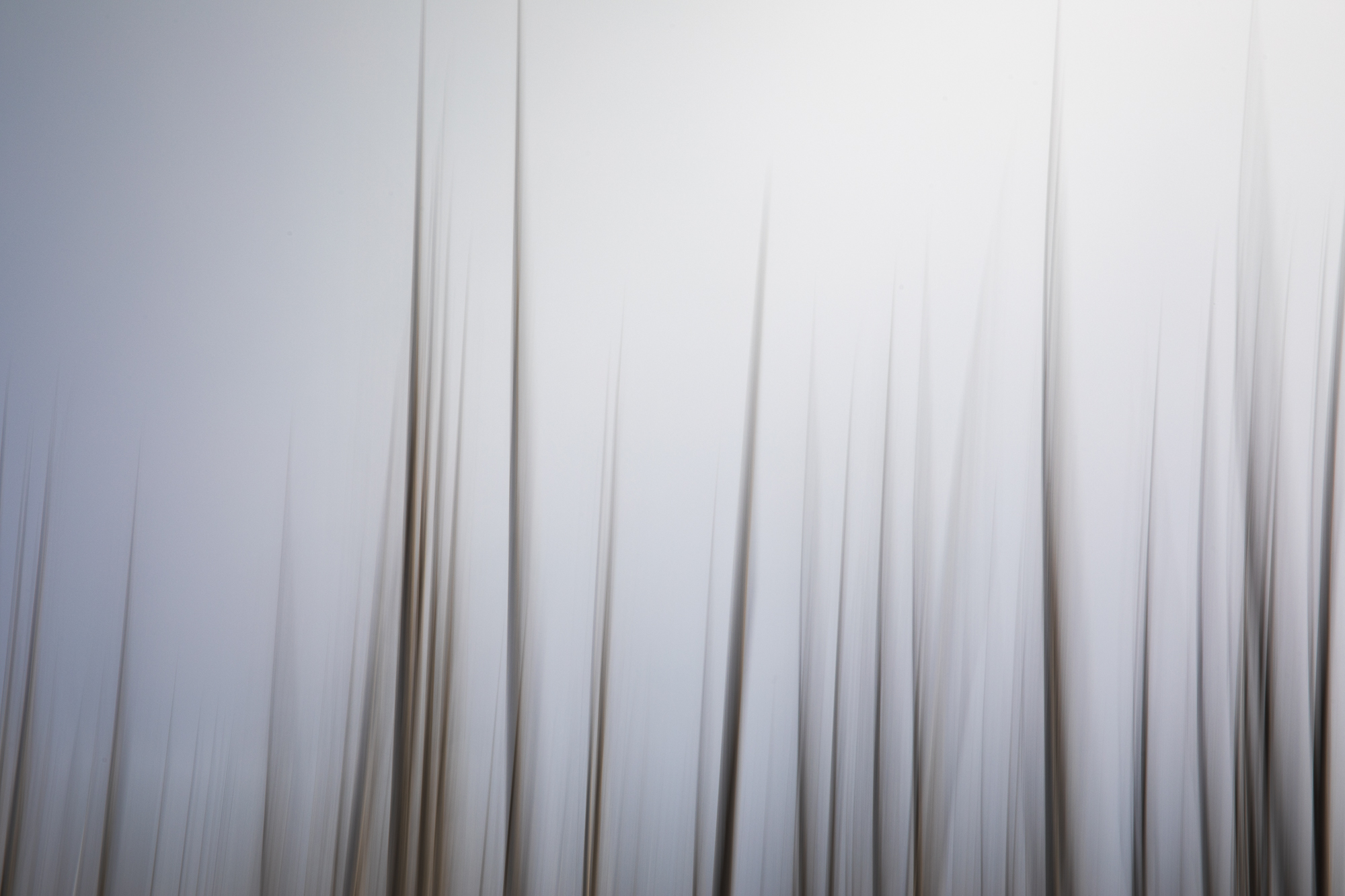This may be my favorite thing to see in the winter...a big bull bison covered in frost. The winter coat of a bison is so well insulating that there isn’t enough heat escaping their body to melt the frost. I’ve been able to photograph this bull several times over the last couple years. His exceptionally red coat, and the red patch on his face, make him easily recognizable.
Idaho Farmland
The simple clean landscape of the Idaho farmland near Driggs, ID.
Bighorn Rams in Jackson Hole
Bighorn sheep are fairly elusive for most of the year, as they spend most of their time in the mountains. In the winter they are forced down to lower elevations to feed and become much more visible.
Solitude - Winter in Yellowstone
Hayden Valley has always been my favorite region of Yellowstone, but photographing it all alone in the quiet of winter is an unforgettable and altogether different experience. We photographed this tree on one my recent photo tours.
Bobby Sock Abstract in Yellowstone
I tried a slightly different approach to bobby socks trees in Yellowstone. I’ve always loved this stand and how symmetrical they are. The temps weren’t cold enough for fog this morning, so I used a motion blur technique to soften the image a bit.
Soaring over the Tetons
A Bald Eagle circles in front of the Teton range to make a second attempt at the raft of coots floating in the lake below.
Red Fox in Grand Teton
There are few things I find more visually striking than a red fox against the white snow. I found this fox as it was hunting for rodents under the snow. The fox will listen carefully for movement under the snow, turning its head back and forth to pin point the sound before leaping into the air and diving head first into the snow.
Tetons over Idaho
A slightly different view of the Teton Range...seen here from the western side towering over Idaho farmlands.
Lodgepole Pine
Lodgepole pine dominates the Greater Yellowstone landscape. The drastically varying heights of the trees are a poignant reminder of a powerful force in the ecosystem, that of fire. This remaining stand of trees high above the Madison River has always impressed me. These few trees somehow survived while everything around them burned to the ground. Though we feel a sense of loss after a major burn, fire is not necessarily a bad thing, nor does it get the last say when it comes to these trees.
The lodgepole pine is equipped to respond to fire in a remarkable way. Their secret is found in a condition called serotiny. Now that we got the fancy word out of the way, what does it even mean? Many of the female cones produced by lodgepole pine remain closed, until they are met with the extreme heat of a fire, at which time the cones open and disperse seeds all over the forest floor. This is why you see such a high density of young trees growing in areas that have previously burned. The smaller trees pictured in the foreground here are 30 years old! They have a long way to go before reaching the heights of their forbears.
The lodgepole pine, making up 80% of the Yellowstone forest, is remarkably resilient in its ability to grow in less than ideal conditions. Here, the poor conditions eventually took their toll. The wet and mineral laden sulfuric soil around hydrothermal features is a tough place to survive.
These trees are known as bobby socks trees because of the white section on the lower trunk which resembles bobby socks. As the trees absorb the water from hydrothermal runoff they also take in minerals. When the water evaporates, the minerals remain and turn the bottom of the trees white.
Grizzly 399
This was my last sighting of grizzly 399 and her two cubs for the season as she made the most of gut piles left over from hunters. It looks like she has denned up for the winter. She was the very first grizzly I saw and photographed. I grew up spending my summers in Jackson, and dreamed of seeing a grizzly from my earliest days, but it took a while. When I finally turned 16 and got my driver’s license I had a little bit more flexibility. With that I was able to go into the field on my own schedule and spend all the time I wanted waiting around. That was the summer I saw her. I remember the adrenaline and excitement like it was yesterday. She will always be very special to me, and I know there are many people who feel similarly.
Spirit Bear - The Catch
A spirit bear snags a silver salmon. Biologists think the white coat makes them more successful when fishing. From the perspective of a fish looking through white water and upwards to the sky, it is a lot easier to detect a black coat, than a white one.
After snorkeling and successfully catching a Silver Salmon, a Spirit Bear shakes off his wet coat. It took me four trips to the Great Bear Rainforest before I had the privilege of photographing the Spirit Bear. It is a rare subspecies of black bear that lives only along the central and northern coast of BC. There are less than 400 Spirit bears in existence, making them one of the rarest bears on the planet.
Bald Eagle Hunt
Bald Eagles key in on waterfowl in the late fall just before the ice takes hold and the open water is gone in Grand Teton National Park. When I arrived at the lake with. I first noticed the group of Red Heads. I looked around a bit more, and I noticed this eagle perched low and just out of sight along the river. I knew it was a matter of time before it made an attempt for the ducks. An hour or so passed and the eagle launched into the air. Flying low and using the topography to its advantage, the eagle had the element of surprise. Even still, it wasn't enough, and after five or six unsuccessful dives the eagle gave up for the afternoon. Nonetheless, it was an adrenaline rush watching the whole event unfold.
Bison - Winter Warriors
As winter settles and temperatures reach -40 degrees, perhaps no animal is as well prepared to survive in this unforgiving climate.
The distinct shoulder hump on their back, which is actually a protruding muscle, allows them to function as a 1 ton, living snow plow. Unlike other ungulates, such as moose and elk, which scrape with their front feet to access food under the snow, bison use this muscle to rock their massive heads back and forth exposing grass and sedge buried under several feet of snow. Some bison will opt out on this “snow-plow” technique, preferring to graze alongside thermal features where the warm steam from geysers or hot springs melts the snow on the surrounding grass.
When violent winter storms hit, prompting other wildlife to seek shelter from the chilling wind and blinding snow, bison just plop down where they are and wait it out. Their winter coats are so thick and well insulated that the falling snow doesn’t even melt on their back. In a heavy snow, you can watch the largest land animal North America vanish before your eyes in a matter of moments.
Teton Moose
I sat with this bull for a while recently as he browsed. This is largest moose I’ve seen this year. The light was pretty flat, but there was a brief 30 second window when the sun broke through and created a beautiful backlit scene against the falling snow....fortunately he picked that very moment to move to a new patch of bitterbrush
Teton Storms
It’s hard to beat this high vantage point for watching storms roll in over the Tetons
The Dive
A humpback whale dives to begin bubble-net feeding in the Great Bear Rainforest.
Grizzly Cubs in the Great Bear Rainforest
Two grizzly bear cubs watch and learn as mom fishes for salmon in the Great Bear Rainforest.
Humpback Whale Bubble-net Feeding
Bubble-net feeding is a strategy requiring remarkable intelligence and teamwork. The lead whale lunges first and locates the fish, while the other whales follow taking the same formation each time. Once the fish are located, the lead whale begins blowing bubbles which functions as a net trapping the fish. Using vocalizations, the whales communicate when to blow more bubbles, and at what point to simultaneously rise to the surface with open mouths and swallow the fish.
























